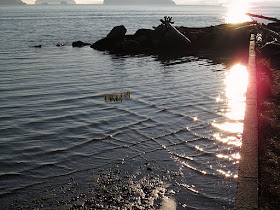Puget Sound Beaches ... not really just gravel, but sand, broken shell, and occasionally a boulder the size of a large truck.
Thursday, December 15, 2011
Ala Spit
Waves are introduced early in oceanography and coastal geomorphology books, since they are a fundamental way by which energy moves through water and by which water moves sediment. One of the most important aspects of waves is their behavior as they reach shore - and terms like reflection, refraction, and diffraction are important concepts, but often misapplied words. There were some nice examples in the little tiny waves at Ala Spit in Monday's low early morning light.
Reflection is the simplest notion, in part because we can all relate to other examples in day to day life - like billiard balls, canyon echoes, and shiny countertops. Here, waves are striking a vertical wall at about 45 degrees. The reflected waves leave the wall at the same angle, creating a mesh of intersecting waves. Where the wave peaks cross, their heights add, doubling the height of the individual waves. This photo also shows how the small waves steepen and grow in height as they arrive in shallow water. One of the most dramatic examples of wave reflection here in the Sound is the havoc on the south side of the Hood Canal Bridge during a strong south wind (Shine, January 2007).
This second picture illustrates both diffraction and refraction (though tough to separate here), as waves wrap around the small bar (and diffract from its ends). Diffraction seems to be the hardest concept to pin down and takes me back to college physics labs, the diffraction of microwaves through narrow slits, and the relevance to the wave-particle character of electromagnetic energy. Refraction is the bending of waves that occurs as waves slow down in shallower water and is an incredibly important concept to coastal geomorphologists and to surfers (these avocations frequently overlap). Reflection also reappears in this photo, since there are a series of waves reaching the far side of the bar that have reflected off of the log in the distance.
AERIAL/MAP VIEW
Tuesday, December 13, 2011
Ala Spit

A lesson in overwash. The frost on this chilly morning highlighted the beautiful overwash fans from past storms, when waves and high tides spilled gravel over the top of the berm and into the backshore. Some of these probably go back many years or decades; others are brand new.
 Since my visit last month (November 11) waves have washed over the newly constructed berm, depositing much of the sand and gravel on the back side of the narrow neck of the spit. The crest of the berm through this area is now only slightly above Mean Higher High Water so this winter's spring highs will continue to flood over the top. The beach face is flat and littered with scattered large cobbles and small boulders and occasional chunks of concrete that were left from the old riprap. The large wood that was placed along the temporary berm has largely washed out.
Since my visit last month (November 11) waves have washed over the newly constructed berm, depositing much of the sand and gravel on the back side of the narrow neck of the spit. The crest of the berm through this area is now only slightly above Mean Higher High Water so this winter's spring highs will continue to flood over the top. The beach face is flat and littered with scattered large cobbles and small boulders and occasional chunks of concrete that were left from the old riprap. The large wood that was placed along the temporary berm has largely washed out.There are some good photos of the tide washing across the spit in the December 5th Whidbey News-Times.
Restoring nature isn't just about removing man made structures and replanting native vegetation; it's also about restoring the physical conditions that created and maintained the landscape in the first place. This means allowing storms and erosion and natural disturbances back into the picture - the very things we often go to such great lengths to control. The trouble is that these dynamic processes are difficult to predict and a site that has been altered for a long period of time will only return to its original condition slowly, and even then, is not likely to return in its original position.
Recovery of the berm will take time and it will take sediment. The first will require patience. The latter will be a challenge, as the neck of this spit is short on sand (and particularly gravel, since this is what best builds robust berms). The foreshore appears to have been starved of sand and gravel due to the development of a bar or proto-spit just to the south. There are also human modifications, including an updrift groin, that complicate the picture. In an ideal world, these other structures might have been removed and perhaps more gravel might have been added to the foreshore to help jump-start a new berm.
I look forward to watching what happens. Meanwhile, I trust that folks walking on the spit will take care to head back to their cars before high tide - lest their feet or their dog gets wet.
AERIAL/MAP VIEW



